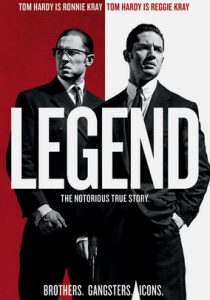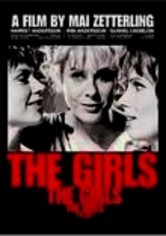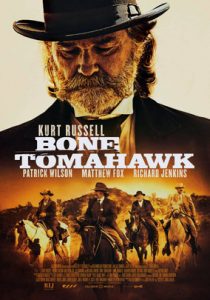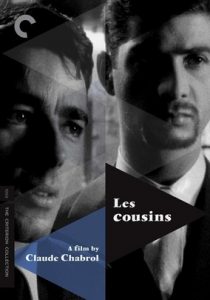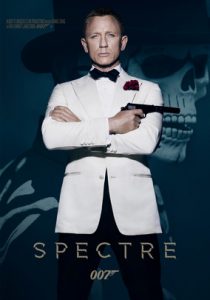Legend-2015
Director Brian Helgeland
Starring Tom Hardy
Scott’s Review #405
Reviewed May 24, 2016
Grade: B+
Tom Hardy is one of my favorite modern film actors (he should have won the 2015 Oscar for his riveting performance in The Revenant, in my humble opinion) and in Legend (2015) fans are treated to a dual role by the handsome Brit.
Hardy portrays Reggie and Ronald Kray, two of London’s most feared and brutal gangsters.
The film belongs to Hardy in every way, shape, and form, the locales of London are fantastic, and more than one scene is jaw-dropping violent, but the film meanders quite a bit and the vocals of Ron Kray are quite difficult to understand.
Still, impressive effort as a whole.
The time is late 1950s London. Reggie Kray, the more mainstream of the Kray brothers, is a feared member of the organized crime community. He is coddled by his mother and can do no wrong in her eyes. This makes any relationships difficult as his mum disapproves of his mates.
He falls in love with Frances Shea, a young woman who narrates most of the film, so it is told from an outsider’s perspective. Reggie’s brother Ron has recently been released from a mental hospital and if off of his medications, is certifiably crazy, and very volatile.
He is gay and makes no bones about it.
Ron and Reggie have a love/hate relationship, and this dynamic is the most interesting aspect.
Thanks to Hardy, as the writing is not Legend’s strongest suit, we see two very different characters, even though they look alike. In the myriad of scenes shared between the brothers, it appears that two actors are playing the roles which is to Hardy’s credit.
An important scene emphasizes the relationship between the two. When a rival dares to mention Reggie’s wife’s name disparagingly, he points a gun and fires at the man’s head.
Fortunately, the gun is not loaded, so the audience breathes a sigh of relief. Yet, a worse fate awaits the victim. After the deed is done, Reggie whispers in Ron’s ear that he killed the man “because I can’t kill you”.
This means Reggie would kill Ron if he could- shocking since they are brothers. To add to this, it is implied that he would kill his brother with the same savageness as his victim.
This makes the audience ponder.
Impressive is Ron’s sexuality, especially since he is not written stereotypically. He is brutal, masculine, and hardcore. The fact that Ron Kray was a real figure is important to note. His entourage of boyfriends follows him around in dedication.
Who can blame them as his charisma oozes- think of an unstable James Bond.
The twin’s relationship is the best part of the film, but as a mob film, Legend meanders quite a bit, so much so that it becomes tough to identify what the point is, if not for Hardy.
Save for Frances, none of the supporting characters are written with interest and are all rather forgettable.
The wonderful Chazz Palminteri is wasted in the role of Angelo Bruno, head of a Philadelphia crime family and friend of the Krays. There is little meaning or interest in his role.
A mediocre story, but with leading characters with depth, makes Legend (2015) an interesting film that flies under the radar and receives little notice.
Hopefully, if nothing else, it continues the success that Tom Hardy is currently achieving in modern film.
